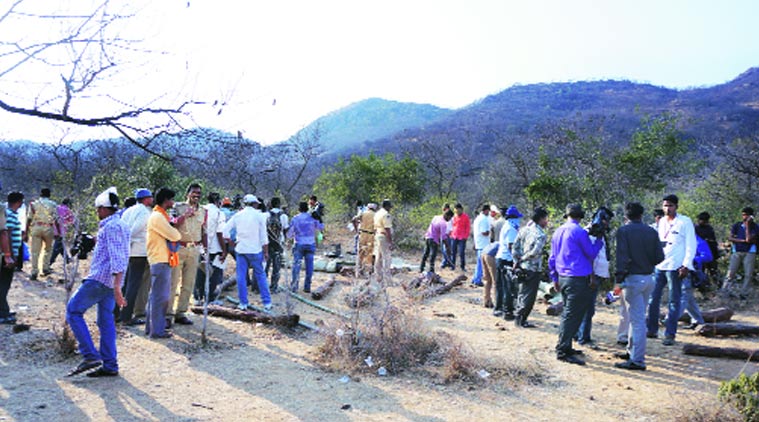Pterocarpus santalinus, with the common names Red Sanders, Red Sandalwood, andSaunderswood, is a species of Pterocarpus endemic to the southern Eastern Ghats mountain range of South India.
http://en.wikipedia.org/wiki/Pterocarpus_santalinus
Red sanders smuggling: those killed are always woodcutters
 Site of the Tirupati encounter. (Source: Express photo)
Site of the Tirupati encounter. (Source: Express photo)Written by Jay Mazoomdaar | New Delhi | Updated: April 8, 2015 1:57 pm
Barring the scale, the encounter killing of 20 red sanders “smugglers” in Andhra Pradesh has not come as a surprise to those watching the illegal industry. Since 2011, such encounters and operations have killed 11 and led to the detention of more than 2,000 — all tribal woodcutters hired by mafia agents from Tamil Nadu.
The timing of the operations reveals a pattern. In 2014, a multi-organisation team led by National Campaign for Denotified Tribes Human Rights (NCDNTHR) probed such killings and detentions and observed:
* If arrested, the local rich in the smuggling racket are sent to the Rajahmundry centralprison, so that they could get bail easily, while the majority of the poor tribal woodcutters are booked under the charges of murder or attempted murder.
* Fortune of rival smuggling groups depends on changing political equations, and targeted killings of tribal labourers of a rival smuggling group through the STF by the dominant group are meant to destroy the opponent’s supply base among Tamil tribals who are hired for felling and carrying red sanders.
“Most of those killed are Vanniyars, a denotified tribe at the bottom of the social hierarchy, while the majority of those detained belong to other tribes. About 300 of them are still in jail since last April,” said Hyderabad-based M Subba Rao, NCDNTHR national convener.
In the name of cracking down on smugglers, say insiders, the politically powerful gangs of the day have taken out members, usually tribal recruits at the lowest rung, of the rival groups. Indeed, red sanders encounters do seem to have been timed with shifts in the state’s political equations since 2011. Consider these:
* A Tamil labourer, named Varadi, was killed in an allegedly fake encounter during the tenure of forest minister Peddireddy Rama Chandra Reddy in 2011.
* After the resignation of Peddireddy in November 2012, another labourer from Tamil Nadu, Murugan, was killed in December 2012.
* Another, named Sambarian Mani, was killed in January 2014, weeks before Kiran Kumar Reddy resigned as chief minister.
* Days before Chandrababu Naidu became chief minister, Vijaykanth, Venkatesh and Siva — all below 25, belonging to denotified tribes and neighbours in an interior village near Javadi hills of Tamil Nadu — were killed in May 2014.
* Another five were killed in the forests of Chittoor and Kadapa districts between June 21 and August 6, 2014.
* Subsequently about 2,000 Tamils were arrested from railway stations and bus stands — rather than crime spots — and branded smugglers and kept in various jails in Nellore, Chittoor and Kadapa districts. Two of them died.
* Last year, the Nellore district jail had about 440 booked in the red sanders case, and of them 236 were booked on the charges of murder and the remaining for attempted murder.

“These tribal woodcutters from Tamil Nadu’s Tiruvannamalai, Salem, Dharamapuri and Villupuram districts traditionally worked in coffee estates and also in sugarcane fields before they were lured by red sander smugglers and their agents. We need independent inquiries into these killings,” said S Anna Durai, Tamil Nadu convener of NCDNTHR.
According to the 2014 report, red sanders smuggling involves four layers of operation. Tribal woodcutters and local carriers/loaders belong to the first rung. At the second stage, transporters operate in connivance with the forest and police departments. Next are the exporters who take it out of the country. At the fourth level are the managers who oversee everything from recruitment to negotiation and report to the political kingpin.
While the woodcutters rarely make more than Rs 10,000 per tree (average 200 kg), the booty fetches between Rs 40-60 lakh per tonne abroad. Last November, the state government earned Rs 1,000 crore by auctioning a huge cache of confiscated red sanders.
A second auction of 3,500 tonnes will be notified soon.
First Published on: April 8, 20152:07 am
http://indianexpress.com/article/india/india-others/the-pattern-those-killed-are-always-woodcutters/
Red sanders fetch uptil Rs 1 crore per ton in China
HYDERABAD: Spurred by an ever-increasing international demand which has led to skyrocketing prices the smuggling of red sanders from the Seshachalam forests has been growing by leaps and bounds. The smugglers, mostly from Tamil Nadu, had started indulging in the illegal trade by buying the wood as cheap as Rs 500 a kg from poor locals and selling it at 100 times the price at the next stage. But with bourgeoning demand, mainly from the far-east countries, red sanders smuggling became a booming business.
According to Andhra Pradesh forest officials, about 25,000 tonnes of red sanders trees were cut down in the last two years causing heavy damage to the delicate ecological balance in the Seshachalam forests. Red sanders trees do not grow anywhere else in the world and it's a highly priced commodity in the international grey market. However, there's virtually no demand in the Indian market. India has promised to protect the red sanders under an IUCN treaty in 2000.
AP government statistics reveal that a tonne of red sanders fetched about Rs 29 lakh in the recent auction of seized logs by the forest department. The state government made a cool revenue of Rs 1,000 crore through an e-auction in September 2014. "But the price in the international market is quite high. It commands a price of Rs 70 lakh per tonne to Rs one crore per tonne in countries like China, Japan and Korea. Unchecked smuggling has been causing loss not only to the forest but also the state exchequer. Unless the government breaks the politician-smuggler nexus, smuggling will continue to flourish," warns environment activist V N Satya.
According to forest officials, the beautiful blood red colour with unique patterns makes red sanders the most sought-after wood. But where the wood finally goes has always remained a mystery. Even the state government does not know its real use. In fact, the AP forest department has ordered a scientific study to find out what the buyers in the international market do with the red sanders. But even as the study is still underway, the demand for this highly endangered wood has been only growing further. It is, however, suspected that red sanders is used in making special musical instruments, nuclear reactors, traditional medicines and as an aphrodisiac. "We are taking up the study to find out the actual use of red sanders. This will help us in protecting the species," said AP's principal chief conservator of forests A V Joseph.
At least six forest officials have lost their lives at the hands of red sanders smugglers since 2012. The AP government formed a joint task force team of forest and police officials last year after smugglers killed two forest officials David Karunakar and Sridhar and critically injured three others in December 2013. Since then, there have been over a dozen violent face-offs between the smugglers and the forest-police teams.
Forest officials in Chittoor point out that the workforce employed by notorious sandalwood smuggler Veerappan in Karnataka-Tamil Nadu had switched their base to Chittoor-Kadapa districts to cut down red sanders. Incidentally, smuggling of red sanders has increased after the death of Veerappan. The modus operandi of red sanders smugglers involves the hiring of hundreds of poor labourers from Tamil Nadu and sending them deep into the Seshachalam forests to cut down the trees. Special buses are hired to ferry the workers. Though red sanders smuggling has been on since the last three decades, it has increased dramatically in the last few years.
According to Andhra Pradesh forest officials, about 25,000 tonnes of red sanders trees were cut down in the last two years causing heavy damage to the delicate ecological balance in the Seshachalam forests. Red sanders trees do not grow anywhere else in the world and it's a highly priced commodity in the international grey market. However, there's virtually no demand in the Indian market. India has promised to protect the red sanders under an IUCN treaty in 2000.
AP government statistics reveal that a tonne of red sanders fetched about Rs 29 lakh in the recent auction of seized logs by the forest department. The state government made a cool revenue of Rs 1,000 crore through an e-auction in September 2014. "But the price in the international market is quite high. It commands a price of Rs 70 lakh per tonne to Rs one crore per tonne in countries like China, Japan and Korea. Unchecked smuggling has been causing loss not only to the forest but also the state exchequer. Unless the government breaks the politician-smuggler nexus, smuggling will continue to flourish," warns environment activist V N Satya.
According to forest officials, the beautiful blood red colour with unique patterns makes red sanders the most sought-after wood. But where the wood finally goes has always remained a mystery. Even the state government does not know its real use. In fact, the AP forest department has ordered a scientific study to find out what the buyers in the international market do with the red sanders. But even as the study is still underway, the demand for this highly endangered wood has been only growing further. It is, however, suspected that red sanders is used in making special musical instruments, nuclear reactors, traditional medicines and as an aphrodisiac. "We are taking up the study to find out the actual use of red sanders. This will help us in protecting the species," said AP's principal chief conservator of forests A V Joseph.
At least six forest officials have lost their lives at the hands of red sanders smugglers since 2012. The AP government formed a joint task force team of forest and police officials last year after smugglers killed two forest officials David Karunakar and Sridhar and critically injured three others in December 2013. Since then, there have been over a dozen violent face-offs between the smugglers and the forest-police teams.
Forest officials in Chittoor point out that the workforce employed by notorious sandalwood smuggler Veerappan in Karnataka-Tamil Nadu had switched their base to Chittoor-Kadapa districts to cut down red sanders. Incidentally, smuggling of red sanders has increased after the death of Veerappan. The modus operandi of red sanders smugglers involves the hiring of hundreds of poor labourers from Tamil Nadu and sending them deep into the Seshachalam forests to cut down the trees. Special buses are hired to ferry the workers. Though red sanders smuggling has been on since the last three decades, it has increased dramatically in the last few years.
http://timesofindia.indiatimes.com/india/Red-sanders-fetch-uptil-Rs-1-crore-per-ton-in-China/articleshow/46843257.cms

